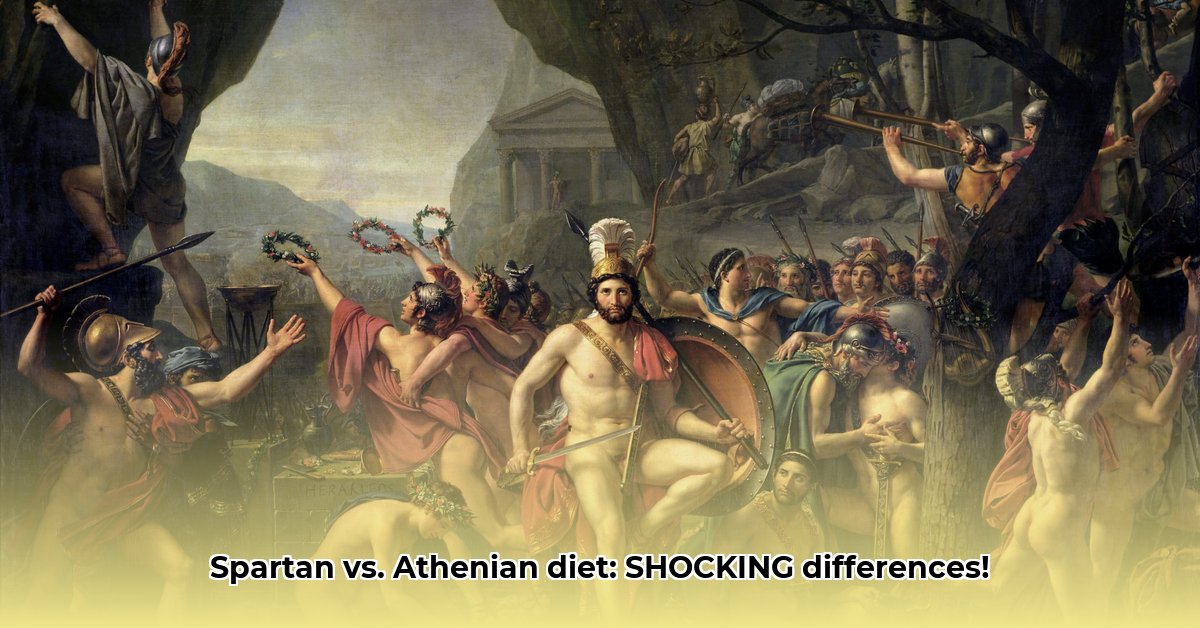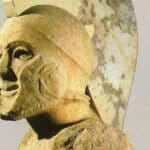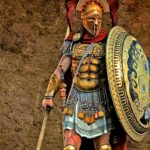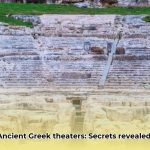Ever wondered what fueled the legendary Spartan warriors or the brilliant minds of Athenian philosophers? Step back in time as we uncover the surprisingly distinct diets of ancient Greece. We’ll explore the simple, protein-rich meals of the Spartans, designed for peak physical performance, and contrast them with the more varied and refined fare enjoyed by Athenian thinkers. From the infamous “black broth” of Sparta to the diverse bounty of Athens, discover how food shaped their lives, cultures, and legacies. Prepare for a fascinating journey through ancient Greek culinary history!
Daily Diet of a Spartan Warrior vs. an Athenian Philosopher: A Tale of Two Cultures
Embark on a historical culinary adventure to compare the daily meals of two iconic ancient Greek figures: the Spartan warrior and the Athenian philosopher. Their dietary habits offer a compelling narrative about their distinct lifestyles, values, and the culinary landscape of their time. Delve into the food diversity, preparation methods, and the vital role food played in shaping their societies.
Spartan Food Habits: Fueling Strength and Discipline
Envision a Spartan warrior: a symbol of strength, discipline, and unwavering readiness for battle. Their diet mirrored these qualities, emphasizing simplicity, functionality, and sustained energy for rigorous training and constant warfare. Discover how food management became a crucial element of their military preparedness.
Barley served as their staple grain, providing a reliable source of carbohydrates for long days of physical exertion. Meat, primarily pork, goat, and mutton, was essential for building and maintaining muscle mass, offering much-needed protein. Cheese added flavor and provided healthy fats. Wine, often diluted with water, was a regular part of their hydration.
Unravel the mystery of the infamous “black broth,” a staple dish shrouded in historical intrigue. While its precise recipe remains elusive, historians speculate on its ingredients and preparation methods. Some believe it was a daily staple, while others suggest it was reserved for special occasions. Despite the uncertainty, the black broth remains a symbol of Spartan culinary identity.
Explore the significance of Spartan communal dining rituals. Meals were not solitary affairs but social events held in communal dining halls called “syssitia.” Beyond mere sustenance, these gatherings served as crucial components of military training and social cohesion, fostering unity, discipline, and camaraderie within the group. Discover how sharing meals strengthened bonds and reinforced the values of Spartan society.
Athenian Food Culture: A Symphony of Flavors
Contrast the Spartan’s austere lifestyle with the refined world of the Athenian philosopher. While Spartan life emphasized physical prowess, Athenian intellectuals valued mental agility and intellectual pursuits. Their diet reflected this contrast, featuring a wider variety of foods, more sophisticated preparations, and a culinary sensibility attuned to contemplation, stimulating cognitive function and intellectual discourse.
Athenians embraced a more diverse range of ingredients and culinary techniques. While grains and legumes remained staples, their plates included a vibrant array of fruits, vegetables, and olives, quintessential elements of the Mediterranean diet. Fish played a significant role, providing an alternative protein source. Meat appeared less frequently than in the Spartan diet, reflecting different priorities in nutrition. Bread, cheese, and an abundance of wine completed the Athenian culinary tableau.
Imagine lively discussions and refined meals, enhanced by the flavors of olive oil and a heightened appreciation for presentation. Athenian meals were integral to their sophisticated culture, offering both nourishment and a social setting for intellectual exchange. Delve into the role of food in shaping Athenian philosophical and artistic endeavors.
Spartan vs. Athenian Nutritional Diversity: A Comparative Overview
Examine the key differences between Spartan and Athenian diets with this comparative overview:
| Feature | Spartan Warrior | Athenian Philosopher |
|---|---|---|
| Main Foods | Barley, meat (pork, goat, sheep), cheese, wine, black broth | Grains, legumes, fruits, vegetables, olives, fish, bread, wine, various cheeses |
| Cooking Style | Simple, functional, focused on sustenance | Diverse, refined,emphasizing flavor and presentation |
| Meal Setting | Communal (syssitia), highly structured, disciplined | Varied, more informal gatherings, social interactions |
| Dietary Focus | Physical strength, endurance, military readiness | Overall health, mental acuity, intellectual pursuits |
| Cultural Significance | Military discipline, social cohesion, austerity | Sophistication, intellectual community, social status |
Ancient Greek Cuisine: Unveiling Culinary Conundrums
Despite our growing understanding, many mysteries surrounding ancient Greek cuisine remain unsolved. Pinpointing the exact ingredients, preparation methods, and nutritional values of ancient meals presents ongoing challenges.
Archaeological digs continue to unearth new clues, shedding light on food remains and uncovering valuable details. Scientists and food historians collaborate to recreate ancient dishes, analyzing their nutritional content and potential health effects. Explore how this interdisciplinary approach enhances our understanding of ancient Greek diets.
Delve into the social dynamics of eating in ancient Greece. How did social classes influence food consumption within Sparta and Athens? Exploring the connections between diet, social hierarchy, and political power provides deeper insights into the complexities of ancient Greek society.
The Legacy of Ancient Diets: Modern Lessons
The contrasting diets of Spartan warriors and Athenian philosophers vividly illustrate how food choices reflected the distinct values and lifestyles of these ancient societies. The Spartan diet, characterized by its simplicity and functionality, prioritized the physical strength required for warfare. The Athenian diet, more varied and sophisticated, supported a culture that revered intellectual pursuits.
By studying these diverse approaches to eating, we gain a richer appreciation for the multifaceted nature of ancient Greek civilization. Ongoing research continues to unveil new insights into these ancient cultures and their fascinating culinary traditions. Discover how these ancient dietary practices inform modern understanding of nutrition and its impact on health and society.
Recreating a Historically Accurate Spartan Diet: A Modern Guide
Let’s embark on a journey to explore the contrasting diets of two iconic figures from ancient Greece: the Spartan warrior and the Athenian philosopher, with a focus on the nutritional requirements of ancient populations. Their daily meals reflect their vastly different lifestyles and societal roles. But how much do we really know about what they ate? And, more importantly, how can we even begin to recreate a historically accurate spartan diet?
A Spartan’s Diet: Simplicity and Strength
The Spartan diet wasn’t simply about survival; it was intrinsically linked to their military ethos. Think of it as a performance-enhancing meal plan, centuries ahead of its time. Their meals aimed to build robust, disciplined warriors. They emphasized food management during various seasons to ensure year-round availability. The foundation was simple: hearty grains like barley, supplemented by meat (primarily pork), cheese, and seasonal fruits. Wine, often diluted with water, was a common beverage.
The famous “black broth” ( melas zomos) remains a mystery. Ancient accounts offer vague ingredients—pork, blood, vinegar, and salt—but the precise recipe is lost to us. Was it simply a hearty stew, or something far more unpalatable? Historians still debate this culinary enigma.
The communal dining system, the syssitia, played a pivotal role. It fostered camaraderie and reinforced Spartan values. This shared mealtime wasn’t just about nutrition; it was about community, thereby contributing to cultural identity.
Athenian Dietary Principles: Refinement and Variety
In contrast to Spartan simplicity, the Athenian diet displayed a broader range of ingredients and culinary sophistication. Athenian philosophers prized intellectual pursuits, their lives less physically demanding than a Spartan warrior’s. Their meals reflected this: a more diverse range of foods, likely including fish, more elaborate preparations, and arguably, finer wines. Wheat bread was a staple, a step up from the common barley bread of Sparta. What are the key principles of Athenian food production in comparison?
While detailed descriptions of a typical Athenian philosopher’s diet are lacking, we can infer from broader societal trends and artistic representations. Their meals were likely more varied, including a wider array of vegetables, fruits, and potentially more exotic ingredients, reflecting Athens’ greater wealth and trade networks.
How To: Steps to Recreate Spartan Diet in the Modern World
While we can’t perfectly replicate an ancient Spartan diet, we can draw inspiration from historical sources to create a historically informed eating plan. This isn’t a crash diet; it’s about understanding the principles. Here’s how to get started:
- Focus on whole grains: Barley is key. Incorporate it into porridges, stews, or breads. Wheat can be added occasionally for a more varied approach.
- Lean protein sources: Pork was a staple. Chicken or lean beef are good modern equivalents.
- Seasonal fruits and vegetables: Figs, grapes, and olives were common. Choose locally sourced produce whenever possible.
- Dairy: Cheese and milk were consumed, offering important nutrients. Choose plain varieties to avoid modern additives.
- Moderate wine consumption: Dilute it with water, as was customary. Don’t overdo it.
It’s crucial to remember that this is a guide, not a rigid regimen. Adapt and adjust based on your individual needs and preferences. The key is understanding the principles guiding Spartan nutrition: simplicity, whole foods, and moderation.
Key Takeaways:
- Spartan and Athenian diets reflected their contrasting lifestyles and societal values.
- The “black broth” remains an enigma, its precise recipe lost to time.
- A historically informed Spartan-inspired diet focuses on whole grains, lean protein, seasonal produce, and moderate wine consumption.
- Accurate recreation of ancient diets requires understanding cultural context and adapting principles to modern availability.
Spartan Diet: Unveiling the Impact of Helot Labor on Food Production
Key Takeaways:
- The Spartan diet, centered on simple, hearty foods, was directly supported by the labor of the helots.
- Helot agriculture enabled Spartan warriors to focus on military training.
- The Athenian philosopher’s diet likely varied widely, reflecting social class and availability.
- Helot labor underpinned the Spartan way of life, fueling their military dominance.
- The contrasting diets directly reflect the contrasting societal structures of Sparta and Athens.
The Spartan Diet: A Product of Helot Labor
Imagine a life dedicated to physical prowess. That was the reality for a Spartan warrior. Their diet, a product of Spartan Diet and the Impact of Helot Labor on Food Production, mirrored this lifestyle: simple, functional, and designed to fuel tireless training. Black broth, a hearty stew, was a staple. Think of it as the ultimate energy drink of its time, what type of calories and supplements. Meat, barley, and cheese supplemented their meals. These were all produced by the helots, a subjugated population providing the agricultural backbone of Spartan society.
Delicacies in Athens: A Meal for the Mind?
Now, picture the Athenian philosopher. Their daily diet is less easily defined. Unlike the Spartans’ uniform fare, an Athenian’s food varied greatly depending on their social standing. Wealthier citizens enjoyed a more varied diet, possibly including fruits, vegetables, fish, and imported delicacies, however access to clean water and reliable sources were still a concern. Whereas a less fortunate Athenian might eat simpler fare, closer in some ways to the Spartan diet, although significantly less abundant. Imagine the discussions around the dinner table—intellectual sparring fueled by olives and wine! But it’s essential to keep in mind that, even for the elite, it is likely the availability and variety of food was still considerably less than what we see in modern society. Did their diets contribute to their intellectual pursuits? It’s a question worth pondering.
Impact of the Helot System: An Engine of Spartan Sustenance
The Spartan Diet and the Impact of Helot Labor on Food Production is inseparable from the helot system. These state-controlled serfs toiled in the fields, producing the surplus that allowed Spartan warriors the time for their rigorous training. This system, though brutal, allowed for a society focused almost entirely on military might. The helots were the engine powering this war machine. Their labor guaranteed the Spartan’s sustenance, their constant fear ensured their control.
Legacy of Ancient Food Choices: Contrasting Lifestyles, Contrasting Diets
The stark difference between Spartan and Athenian diets is a reflection of their vastly different societies. Sparta prioritized military strength above all else. Their diet, austere and utilitarian, was a tool in that pursuit. Are those diets better or worse in comparison to modern ones. Athens, famed for its intellectual and artistic achievements, fostered a more diverse culinary landscape reflecting a wider range of social classes and lifestyles. One society built on discipline and strength; the other on intellect and democracy. Their contrasting culinary habits tell a powerful story.
Understanding the Nutritional Comparison of Spartan and Athenian Diets: A Regional Perspective
Key Takeaways:
- Spartan diets prioritized functionality and communal eating, reflecting their militaristic society.
- Athenian diets likely showed greater variety and culinary sophistication, mirroring their more diverse society.
- Both diets shared core Mediterranean elements, but their emphasis and preparation differed dramatically.
- Reliable historical data on precise caloric intake and nutritional composition is scarce for both groups.
- Further research using anthropological and nutritional analyses could enhance our understanding.
Spartan Commensality: Function over Flavor?
Imagine a Spartan warrior’s daily fare. Think simple, hearty, and functional—fuel for a life of rigorous training and warfare. Their diet revolved around the Syssitia, communal mess halls where warriors shared meals. Meat featured prominently—pork, goat, beef, and even boar. Barley bread formed the staple grain, supplemented by cheese, olives, and various fruits. Wine, usually diluted, was a common beverage. The infamous “black broth” ( melas zomos) remains shrouded in mystery; its exact recipe and role in their diet are still debated. Was it a daily staple, or a less frequent, perhaps even ritualistic, dish? We can only speculate. Nutritional Comparison of Spartan and Athenian Diets: A Regional Perspective highlights the reliance on locally sourced ingredients. Hunting, a vital skill for Spartans, provided additional protein. This diet, reflecting their culture, fostered camaraderie and ensured sufficient sustenance for arduous physical activity. But did this simple diet provide optimal nutrition? That’s a question we’ll consider later.
Athenian Delicacies: A More Refined Approach
Now picture an Athenian philosopher. Their lives, unlike the Spartans’, weren’t dedicated to constant physical exertion. Their diet likely allowed for more culinary sophistication and variety. While grains, fruits, and vegetables were essential, Athenian cuisine incorporated more olive oil, diverse spices, and finer cuts of meat. They enjoyed a wider array of fruits, vegetables, and seafood. The Athenian diet arguably offered a more balanced nutritional profile, reflecting the city’s greater access to resources and more diverse social structure. Think of the feasts described in Plato’s dialogues—a far cry from the Spartan Syssitia. Was this refined diet healthier? It might have been, offering more diverse nutrients. But did this varied diet lead to physical limitations compared to the Spartan warrior? This reflects the key themes of Nutritional Comparison of Spartan and Athenian Diets: A Regional Perspective.
Cultural Lifestyles: A Comparative Glance
Let’s contrast these two approaches. Both diets rooted themselves in the Mediterranean world—yet, the emphasis was distinctly different. The Spartan diet emphasized quantity and practicality, ensuring adequate energy for their physically demanding lifestyle. The Athenian diet showed greater diversity and refinement, reflecting their intellectual pursuits and broader access to resources. However, assessing which truly held a “healthier” profile is challenging due to the limitations of available historical evidence.
Food Science And Anthropology: Unanswered Questions and Future Research
While textual sources and archeological findings provide glimpses into these ancient diets, much remains uncertain. We lack precise quantitative data on caloric intake, macronutrient ratios, and micronutrient levels for either group. Further research, applying modern nutritional science, can enrich our knowledge significantly. More comprehensive analysis of historical and archaeological evidence—combined with anthropological investigation into the health and longevity of both Spartans and Athenians—could shed light on this intriguing culinary and historical comparison. Such studies hold the key to enhancing our understanding of Nutritional Comparison of Spartan and Athenian Diets: A Regional Perspective.
- Understand the Dunning-Kruger Effect: Why Incompetent People Think They’re Experts: Gain Self-Awareness - August 1, 2025
- Ignaz Semmelweis: The Doctor Fired for Handwashing: A Public Health Tragedy - August 1, 2025
- Unlock Your Memory: Spaced Repetition: The Scientific Trick to Remembering Information Forever: Learn Effortlessly - August 1, 2025
















